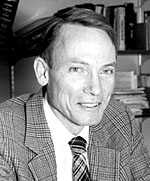Prize Recipient

William Happer
Princeton University
Citation:"For his research leading to fundamental understanding and applications of atomic processes on spin or excitation transfer through atomic collisions."
Background:Dr. William Happer, a Professor in the Department of Physics at Princeton University, is a specialist in modern optics, optical and radiofrequency spectroscopy of atoms and molecules, and spin-polarized atoms and nuclei. He received a B.S. degree in Physics from the University of North Carolina in 1960 and the Ph.D. degree in Physics from Princeton University in 1964.
He was a member of the Physics Department of Columbia University from 1964 until 1980, when he joined the faculty at Princeton University. From 1991 until 1993 he served as Director of Energy Research in the Department of Energy, where he oversaw a basic research budget of some $3 billion, which included much of the federal funding for high energy and nuclear physics, materials science, magnetic confinement fusion, environmental science, the human genome project. He was reappointed Professor of Physics at Princeton University in 1993, and Chair of the Princeton University Research Board in 1995.
He is a Fellow of the American Physical Society, the American Association for the Advancement of Science, and is a member of the American Academy of Arts and Sciences, the National Academy of Sciences and the American Philosophical Society. He was awarded an Alfred P. Sloan Fellowship in 1966, an Alexander von Humbolt Award in 1976 and the Broida Prize of the American Physical Society in 1997.
His current research interests are focused on how on various gas-phase collisional interactions and wall interactions limit the large spin polarization produced by optical pumping of the magnetic resonance imaging isotopes, 3He and 129Xe. Dr. Happer's group at Princeton has designed and built MRI equipment using hyperpolarized gases which provide enhanced photos and images without the risks of radiation exposure associated with other imaging techniques. This equipment is in use at the University of Virginia and can be seen in action at the Hyperpolarized Noble Gas Magnetic Resonance Website.
Selection Committee:
Chun C Lin (Chair), Barry Irwin Schneider, Sheldon Datz ('98 Recipient), John Edward Thomas (Vice Chair), Daniel Kleppner
